Lesson: Lift and Pull
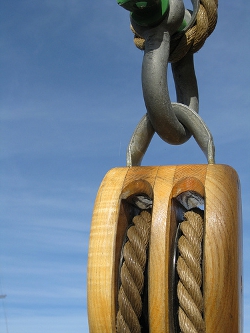 (Lesson Plan courtesy of TeachEngineering.)
(Lesson Plan courtesy of TeachEngineering.)
Grade Level: 6-8
Time Required: 50 minutes
Expendable Cost Per Group : US $5 (Group Size: 3)
Overview
In this activity, students gain first-hand experience with the mechanical advantage of pulleys. Students are given the challenge of helping save a whale by moving it from an aquarium back to its natural habitat into the ocean. They set up different pulley systems, compare the theoretical and actual mechanical advantage of each and discuss their recommendations as a class.
Engineers need to know the measured effectiveness of the tools they use. This can be learned through experience or calculated theoretically. A pulley is a simple machine often used in engineering activities and accordingly has a measurable effectiveness, or mechanical advantage. Pulleys are good machines for lifting heavy objects over a direct vertical path. Pulleys are often incorporated into the design of various engineering systems such as the crane, where huge loads are manipulated with a little force supplied by a relatively small motor. Cranes can be seen moving buildings, boats, large animals, and even swimming pools.
Educational Standards
Colorado Math (Grades 5-8, 2005)
o 2. describe patterns using variables, expressions, equations, and inequalities in problem-solving situations;
o 5. solve simple linear equations in problem-solving situations using a variety of methods (informal, formal, graphical) and a variety of tools (physical materials, calculators, computers).
o 1. estimate, use, and describe measures of distance, perimeter, area, volume, capacity, weight, mass, and angle comparison;
o 4. select and use appropriate algorithms for computing with commonly used fractions and decimals, percents, and integers in problem-solving and determine whether the results are reasonable.
Colorado Science (Grades 0-12, 1995)
o 2.3 Students understand that interactions can produce changes in a system, although the total quantities of matter and energy remain unchanged.
o Standard 5: Students know and understand interrelationships among science, technology, and human activity and how they can affect the world.
o Standard 1: Students understand the processes of scientific investigation and design, conduct, communicate about, and evaluate such investigations.
More standards can be found here.
Pre-requisite Knowledge
Students should be familiar with the six simple machines, as discussed in Lesson 1 of this unit, “The Advantage of Machines.” Also, students should have some understanding of basic mechanical advantage.
Learning Objectives
After this activity, students should be able to calculate the mechanical advantage of a pulley and explain why the concept of mechanical advantage is useful for engineers.
Materials List
Each group needs:
* Approximately 20 feet of nylon rope
* Two-wheeled pulley
* Single pulley
* Spring scale
* String
* Weight (can use soup cans, rocks, weights, etc.)
* 3 copies of the Pulley Worksheet
Attachments:
* Pulley Worksheet (.doc)
* Pulley Worksheet (.pdf)
Introduction/Motivation
Ask students for some examples of tools and list their answers on the chalk/white board. Some different kinds of tools: hand tools, power tools, big tools, small tools, tools with specific uses, tools with many uses, and so on. How should a tool be defined? Should it include work? Ask the students and write their definitions on the chalk/white board. Their answers should be something similar to: a tool is a thing used by people while doing work.
One example of a simple tool is a pulley. (Show the class a pulley.) Ask the class if they know what the purpose of a pulley is. (Answer: A pulley is usually used for lifting something up, sometimes pulling something.) How can the effectiveness of a system of pulleys be measured? (Answer: We would calculate the mechanical advantage.) The mechanical advantage of all six simple machines is defined by the general expression:
 However, this expression is usually too general. The most precise method for calculating the mechanical advantage of a pulley is by counting the number of ropes or cables that support the load. Then the mathematical relationship is simply expressed as:
However, this expression is usually too general. The most precise method for calculating the mechanical advantage of a pulley is by counting the number of ropes or cables that support the load. Then the mathematical relationship is simply expressed as:
 There is another way to determine mechanical advantage. It can be measured directly by measuring the decrease in force used to lift an object. This is the actual mechanical advantage.
There is another way to determine mechanical advantage. It can be measured directly by measuring the decrease in force used to lift an object. This is the actual mechanical advantage.
The mechanical advantage of pulleys has been used by engineers for thousands of years. Archimedes (b. 287 BC, d. 212 BC) was a Greek thinker and engineer. When Rome was attacking Syracuse (where Archimedes lived), he devised a pulley attached to a great lever that extended over a rock wall and dangled a giant hook. When Roman ships approached, the hook was lowered, grabbing the ships. The pulley then lifted the huge ships out of the water, only to drop them back down with a devastating crash. Since then, countless engineers have used pulleys to lift heavy objects for a variety of different purposes. Pulleys designed by engineers can be found on assembly lines, construction sites and other places where heavy objects need to be moved.
In this activity, ask students to imagine that marine biologists at an aquarium in California have been working to save a sick gray whale that was found off the coast of Big Sur. The gray whale has been in their care for several months and is now completely healthy. The students work at the engineering firm that they have hired to design a lift that will safely remove the whale from the aquarium and move it back into its natural environment. They will need to design a system that can lift the 16 ton (32,000 pound) whale to a certain height in order to be moved back into coastal waters.
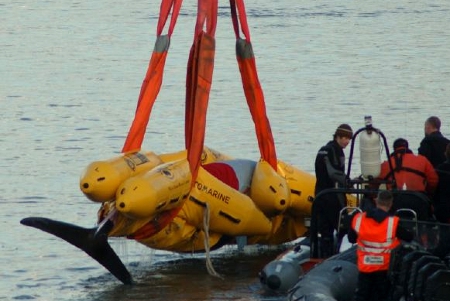
As engineers, we know that there are several steps that need to be completed in the design of a solution for any technical problem. The first step in designing a proper solution is to recognize the need. Who is the customer that we need to make happy? In this case, it is the aquarium, the whale, and perhaps the citizens who have been keeping track of the whale’s story in the news.
The next step is defining the problem needs. Ask the students to give one way that the problem of moving the whale could be phrased. (Discuss with the class. Answers should not limit the solutions, so one idea may be: get the whale back to the ocean safely.) Next, an engineer would think about information that might help to solve the problem. Needed information might include the constraints or limitations on the problem, such as money or time the whale can be out of the water, but the students (engineers) should also consider what they need to know to solve the problem.
Tell students that they will be looking at various pulleys as a way to lift the whale out of the tank in the aquarium. The class will be setting up different pulley systems and examining if the theoretical mechanical advantage is the same as the actual. They will test the calculations they will make for the mechanical advantage of the pulleys. The students will learn if these calculations actually predict what happens in the real world. After they learn about pulleys and their mechanical advantage, they will brainstorm ideas for the whale lift to present to the aquarium.
Procedure
Before the activity, gather materials and make copies of Pulley Worksheet.
Distribute materials and the Pulley Worksheet. Allow students to stand on desks or ladders to hang the two-wheeled pulley on the ceiling.
Have the students follow the instructions on the Pulley Worksheet for measuring the weight (load) of the object, effort and mechanical advantage of several pulley systems. Have the students discuss the theoretical mechanical advantages in comparison to the actual ones.
Lastly, engage the students in discussion of their activity. What were some possible sources of error in their procedure? What recommendations would they make as engineers to the aquarium trying to move the gray whale back to the ocean? Would they use pulleys? What are some constraints that they as engineers might consider while designing a pulley system for the whale? What impacts to the whale might they need to consider for moving it back to the ocean?
Troubleshooting
Remind students to be cautious when standing on desks to hang their pulleys. They should NOT rock their desks or try to jump from desk to desk.
If students are having trouble reading the spring scales, tell them to pull on it consistently.
Assessment
Pre-Activity Assessment
Brainstorming: In small groups, have the students engage in open discussion. Remind students that no idea or suggestion is “silly.” All ideas should be respectfully heard. Ask the students:
* How many devices can you think of that contain pulleys? (Some examples include: assembly lines, cranes, construction sites and other places where heavy objects need to be moved.)
Activity Embedded Assessment
Worksheet: Have the students record measurements and follow along with the activity on their Pulley Worksheet. After students have finished their worksheet, have them compare answers with their peers.
Question/Answer: Ask students questions and have them raise their hands to respond. Write answers on the board and discuss as a class.
* Are the theoretical and actual mechanical advantages similar for each pulley system? (Have students answer on their worksheet.)
Post-Activity Assessment
Design Requirements and Constraints: Have the students make a list on the board of the problem’s design requirements and constraints. Some examples might include: budget for materials, time, safety and impact on the whale, ethical and social impacts.
Engineering Design: Engineers need to be able to communicate their ideas effectively to their audience. Have students create a design of their pulley system on a blank sheet of paper for the aquarium. What recommendations would they make as engineers to the aquarium trying to move the gray whale back to the ocean? What is some other information they might want to know in order to design their lift effectively?
Journal Writing: Have students write a journal entry on the results of the activity. The entry should summarize the results and discuss why knowing the mechanical advantage of a machine is useful.
Activity Extensions
Have students research the Greek thinker and engineer Archimedes. What did he invent? Which of his inventions include one or more simple machines?
References
U.S. Department of Transportation, Federal Highway Administration, Bridge Technology, “Accelerated Bridge Construction,” July 7, 2006, accessed August 31, 2007.
Contributors
Michael Bendewald, Jake Lewis, Malinda Schaefer Zarske, Janet Yowell
© 2007 by Regents of the University of Colorado. This digital library content was developed by the Integrated Teaching and Learning Program under National Science Foundation GK-12 grant no. 0338326. However, these contents do not necessarily represent the policies of the National Science Foundation, and you should not assume endorsement by the federal government.
Supporting Program: Integrated Teaching and Learning Program, College of Engineering, University of Colorado at Boulder
“Pulley Block” by Matti Mattila (Flickr Commons)
“DSC_7235” by John Pannell (Flickr Commons)
Activity: Machines and Tools, Part II
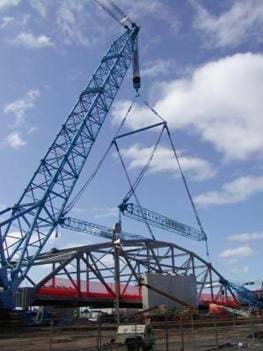 |
|
Figure 1. The world’s largest crane, or an example of a pulley.
click for copyright |
|
Summary In this activity, students gain first-hand experience with the mechanical advantage of pulleys. Students are given the challenge of helping save a whale by moving it from an aquarium back to its natural habitat into the ocean. They set up different pulley systems, compare the theoretical and actual mechanical advantage of each and discuss their recommendations as a class. |
|
Engineering Connection Engineers need to know the measured effectiveness of the tools they use. This can be learned through experience or calculated theoretically. A pulley is a simple machine often used in engineering activities and accordingly has a measurable effectiveness, or mechanical advantage. Pulleys are good machines for lifting heavy objects over a direct vertical path. Pulleys are often incorporated into the design of various engineering systems such as the crane, where huge loads are manipulated with a little force supplied by a relatively small motor. Cranes can be seen moving buildings, boats, large animals, and even swimming pools. |
|
Contents |
| Grade Level: 7 (6-8) | Group Size: 3 |
| Time Required: 50 minutes |
Activity Dependency
 :Simple Machines Unit, Lesson 3 :Simple Machines Unit, Lesson 3 |
| Keywords: pulley, mechanical advantage, work, simple machine | |
| Reviews: Read Reviews | Be the First to Write a Review | |
| subject areas | Physical Science |
| curricular units | Simple Machines |
| lessons | Levers that Lift |
Pre-Req Knowledge (Return to Contents)
Students should be familiar with the six simple machines, as discussed in Lesson 1 of this unit,”The Advantage of Machines.” Also, students should have some understanding of basic mechanical advantage.
Learning Objectives (Return to Contents)
After this activity, students should be able to:
- Calculate the mechanical advantage of a pulley.
- Explain why the concept of mechanical advantage is useful for engineers.
Materials List (Return to Contents)
Each group needs:
- Approximately 20 feet of nylon rope
- Two-wheeled pulley
- Single pulley
- Spring scale
- String
- Weight (can use soup cans, rocks, weights, etc.)
- 3 copies of the Pulley Worksheet
Introduction/Motivation (Return to Contents)
What are some examples of tools? (List students’ answers on the chalk/white board.) There are many different kinds of tools: hand tools, power tools, big tools, small tools, tools with specific uses, tools with many uses, and so on. What is a good way to define a tool — a definition that includes all of these examples? Should it include work? (Write students’ definitions on the chalk/white board. Their answers should be something similar to: a tool is a thing used by people while doing work.)
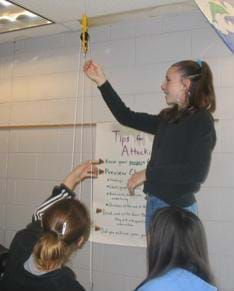 |
|
Figure 2. Students raising their activity pulley set.
click for copyright |
One example of a simple tool is a pulley. (Show the class a pulley.) Who knows its purpose? (Answer: A pulley is usually used for lifting something up, sometimes pulling something.) How can we measure the effectiveness of a system of pulleys? (Answer: We would calculate the mechanical advantage.) The mechanical advantage of all six simple machines is defined by the general expression:
 |
However, this expression is usually too general.
The most precise method for calculating the mechanical advantage of a pulley is by counting the number of ropes or cables that support the load. Then the mathematical relationship is simply expressed as:
 |
There is another way to determine mechanical advantage though. We can measure it directly by measuring the decrease in force used to lift an object. Let’s refer to this as the actual mechanical advantage.
The mechanical advantage of pulleys has been used by engineers for thousands of years. Archimedes (b. 287 BC, d. 212 BC) was a Greek thinker and engineer. When Rome was attacking Syracuse (where Archimedes lived), he devised a pulley attached to a great lever that extended over a rock wall and dangled a giant hook. When Roman ships approached, the hook was lowered, grabbing the ships. The pulley then lifted the huge ships out of the water, only to drop them back down with a devastating crash. Since then, countless engineers have used pulleys to lift heavy objects for a variety of different purposes. Pulleys designed by engineers can be found on assembly lines, construction sites and other places where heavy objects need to be moved.
We have now learned how to calculate mechanical advantage for pulleys. Today, we are going to work on an engineering scenario that has actually happened in years past. For our activity today, imagine that Marine biologists at an aquarium in California have been working to save a sick gray whale that was found off the coast of Big Sur. The gray whale has been in their care for several months and is now completely healthy. We work at the engineering firm that they have hired to design a lift that will safely remove the whale from the aquarium and move it back into its natural environment. We will need to design a system that can lift the 16 ton (32,000 pound) whale to a certain height in order to be moved back into coastal waters.
As engineers, we know that there are several steps that need to be completed in the design of a solution for any technical problem. The first step in designing a proper solution is to recognize the need. Who is the customer that we need to make happy? In this case, it is the aquarium, the whale, and perhaps the citizens who have been keeping track of the whale’s story in the news.
The next step is defining the problem needs. What is one way that we could phrase this problem with moving the whale? (Discuss with the class. Answers should not limit the solutions, so one idea may be: get the whale back to the ocean safely.) Next, an engineer would think about information that might help to solve the problem. Needed information might include the constraints or limitations on the problem, such as money or time the whale can be out of the water, but we would also consider what we need to know to solve the problem.
Today, we are going to look at various pulleys as a way to lift the whale out of the tank in the aquarium. We will be setting up different pulley systems and examining if the theoretical mechanical advantage is the same as the actual. We are going to test the calculations we make for the mechanical advantage of the pulleys. We will learn if these calculations actually predict what happens in the real world. After we learn about pulleys and their mechanical advantage, we will brainstorm ideas for the whale lift to present to the aquarium.
Procedure (Return to Contents)
Before the Activity
- Gather materials.
- Make copies of Pulley Worksheet.
With the Students
- Distribute materials and the Pulley Worksheet.
- Allow students to stand on desks or ladders to hang the two-wheeled pulley on the ceiling, as shown in Figure 3.
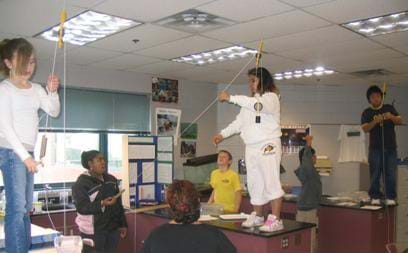 |
|
Figure 3. Students attaching their activity pulley to the ceiling.
click for copyright |
- Have the students follow the instructions on the Pulley Worksheet for measuring the weight (load) of the object, effort and mechanical advantage of several pulley systems.
- Have the students discuss the theoretical mechanical advantages in comparison to the actual ones.
- Lastly, engage the students in discussion of their activity. What were some possible sources of error in their procedure? What recommendations would they make as engineers to the aquarium trying to move the gray whale back to the ocean? Would they use pulleys? What are some constraints that they as engineers might consider while designing a pulley system for the whale? What impacts to the whale might they need to consider for moving it back to the ocean
Safety Issues (Return to Contents)
Remind students to be cautious when standing on desks to hang their pulleys. They should NOT rock their desks or try to jump from desk to desk.
Troubleshooting Tips (Return to Contents)
If students are having trouble reading the spring scales, tell them to pull on it consistently.
Assessment (Return to Contents)
Pre-Activity Assessment
Brainstorming: In small groups, have the students engage in open discussion. Remind students that no idea or suggestion is “silly.” All ideas should be respectfully heard. Ask the students:
- How many devices can you think of that contain pulleys? (Some examples include: assembly lines, cranes, construction sites and other places where heavy objects need to be moved.)
Activity Embedded Assessment
Worksheet: Have the students record measurements and follow along with the activity on their Pulley Worksheet. After students have finished their worksheet, have them compare answers with their peers.
Question/Answer: Ask students questions and have them raise their hands to respond. Write answers on the board and discuss as a class.
- Are the theoretical and actual mechanical advantages similar for each pulley system? (Have students answer on their worksheet.)
Post-Activity Assessment
Design Requirements and Constraints: Have the students make a list on the board of the problem’s design requirements and constraints. Some examples might include: budget for materials, time, safety and impact on the whale, ethical and social impacts.
Engineering Design: Engineers need to be able to communicate their ideas effectively to their audience. Have students create a design of their pulley system on a blank sheet of paper for the aquarium. What recommendations would they make as engineers to the aquarium trying to move the gray whale back to the ocean? What is some other information they might want to know in order to design their lift effectively?
Journal Writing: Have students write a journal entry on the results of the activity. The entry should summarize the results and discuss why knowing the mechanical advantage of a machine is useful.
Activity Extensions (Return to Contents)
Have students research the Greek thinker and engineer Archimedes. What did he invent? Which of his inventions include one or more simple machines?
References (Return to Contents)
U.S. Department of Transportation, Federal Highway Administration, Bridge Technology, “Accelerated Bridge Construction,” July 7, 2006, accessed August 31, 2007. http://www.fhwa.dot.gov/bridge/crane27.htm
Contributors
Michael Bendewald, Jake Lewis, Malinda Schaefer Zarske, Janet Yowell
Copyright
© 2007 by Regents of the University of Colorado. This digital library content was developed by the Integrated Teaching and Learning Program under National Science Foundation GK-12 grant no. 0338326. However, these contents do not necessarily represent the policies of the National Science Foundation, and you should not assume endorsement by the federal government.
Supporting Program (Return to Contents)
Integrated Teaching and Learning Program, College of Engineering, University of Colorado at Boulder
Filed under: Class Activities, Grades 6-8, Grades 6-8, Lesson Plans
Tags: Class Activities, Lesson Plan, Mechanical engineering, Physical Science, Physics, Science Lesson Plans









